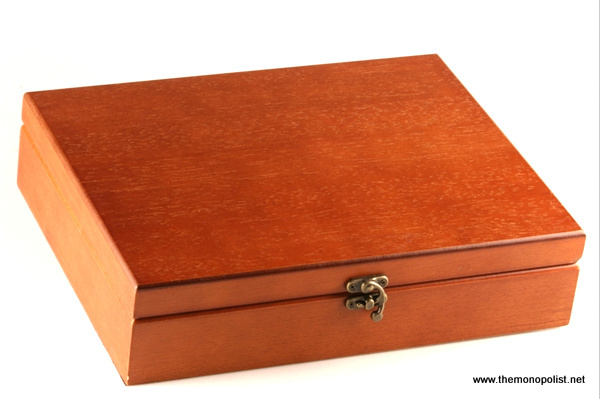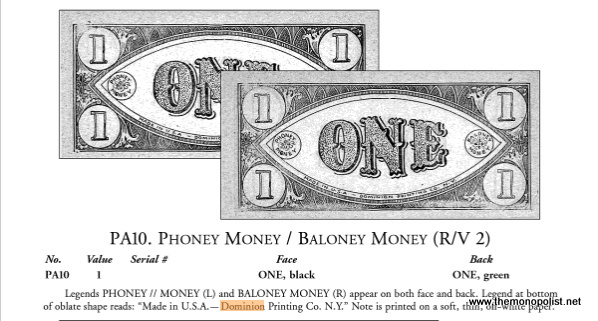
In the series, George S. Parker adds the metal tokens to the Monopoly game… using, possibly, one of my handmade Round Game board recreations(!), and with illustrations of metal tokens taken from the later Monopoly patent. In real life the tokens were introduced to the game by a group of children, and Darrow liked them so much that he suggested that Parker Brothers use them in the game, once they took over. He had wanted to use them, but could not find a supplier, according to his son, William Darrow.
I recently watched The Toys That Built America, a four-part miniseries on the History Channel. The history was very superficial, and where do I begin on all the things they got wrong?
I can appreciate how shows like this can educate the public, and potentially expand interest in the history of Monopoly and other games. However, parts of what was shown were historically inaccurate. I would think that the producers of such shows have a responsibility to get it right. Showing Charles Darrow and saying “he calls it Monopoly,” implies that he was the first one who called it that, which he was not. Stating later that almost everything he claimed was not true does not undo the damage.
Honestly, how would it even be possible that a truthful account could undermine the validity of the Monopoly trademark at this late date?
Everything about the history of Monopoly between Elizabeth Magie and Darrow was completely left out of the story, and this is a crucial part of the story! The Quaker originators of Atlantic City Monopoly only get mentioned in passing, with nothing to indicate that they even called their game Monopoly. The series appears to have been made in close association with Hasbro and Mattel, which are huge corporate interests, almost as if they were large-scale infomercials.
They show Charles Darrow coloring his Round Board game with chalk. In real life, I am sure he used paint.
In the TV version, Darrow learns the Atlantic City version of the game, but there is absolutely no mention that anyone called the game Monopoly before he did. In actuality, the game was widely known as Monopoly for years before Darrow ever caught wind of it. Why was all this left out?
They show Milton Bradley and Parker Brothers evaluating Darrow’s Monopoly in 1934 by studying a Round Board. Darrow only made one round board, and it stayed in his family. In 1934, he likely would have sent them Darrow White Boxes.
They say that Parker Brothers added the iconic tokens to Monopoly. While this is true, Darrow suggested the use of these metal tokens, which he had wanted to use in his sets, but had been unable to find a supplier. Years ago, I spoke to a woman, 85 years old at the time, who had been in Darrow’s circle as a child. She told me the real story of how metal dime store tokens were added to the game.
Darrow worked odd jobs as a handyman during the Depression. While he was working at someone’s house in his neighborhood, he brought along a Monopoly set for the kids to play with. They couldn’t finish a game in one sitting, and had trouble remembering whose colored token was whose the next day.
So six kids each picked out their favorite dime store token, and Darrow liked the idea so much that these became the first six tokens used in Parker Brothers sets. The same metal tokens became part of the Monopoly patent, which means Parker credited the idea to Darrow. Parker Brothers did not include any of their own improvements in the Darrow patent.
They referred to the Monopoly patent as a “design patent.” It is not. A design patent was something that Milton Bradley took out for one of their early versions of Easy Money, because they were shut out in getting a conventional patent.
Monopoly was already a hit game when Parker Brothers approached Elizabeth Magie Phillips about purchasing her second Landlord’s Game patent. So it is disingenuous when the narrator in the documentary says that Parker did not know that there were millions of dollars at stake. By November 1935, over 100,000 Monopoly sets had been sold, and Parker Brothers was just getting warmed up with it.
Elizabeth Magie Phillips was a Georgist (a follower of Henry George) and they were opposed to monopolies. What is a patent, if not a legalized monopoly on an invention? EMP took out patents so she would get credit for her inventions, but to use them as a way to make money would have been contrary to her Georgist beliefs.
This is why she did not accept a royalty from Parker Brothers on the sale of Monopoly games. If necessary, they obviously would have paid her a royalty, and most likely would have cut Darrow’s, or eliminated it entirely. (See our recent post The Fortunes of Fortune, November 29, 2021>(
We can forgive how the actor portraying Charles Darrow looked very little like the balding man he was in real life, or how the actor playing the elderly George S. Parker was obviously a young man. I don’t really think Parker Brothers held a press conference when they took over Monopoly from Charles Darrow; hardly anyone knew what it was yet, and at that point, it certainly wasn’t newsworthy.
We can chalk these things off to artist license, but there is no way Darrow colored his Round Board with chalk!
I like to steer a middle ground between the “Billion Dollar Monopoly Swindle” and the Parker Brothers/Hasbro corporate sides of this history. Unfortunately we usually only get one side, or the other. Mary Pilon‘s book was in the former category, while last night’s TV show was definitely in the latter. I think the truth is somewhere in between the two.
-David Sadowski

According to this series, Darrow sells out to Parker in 1934. It was actually 1935.























































